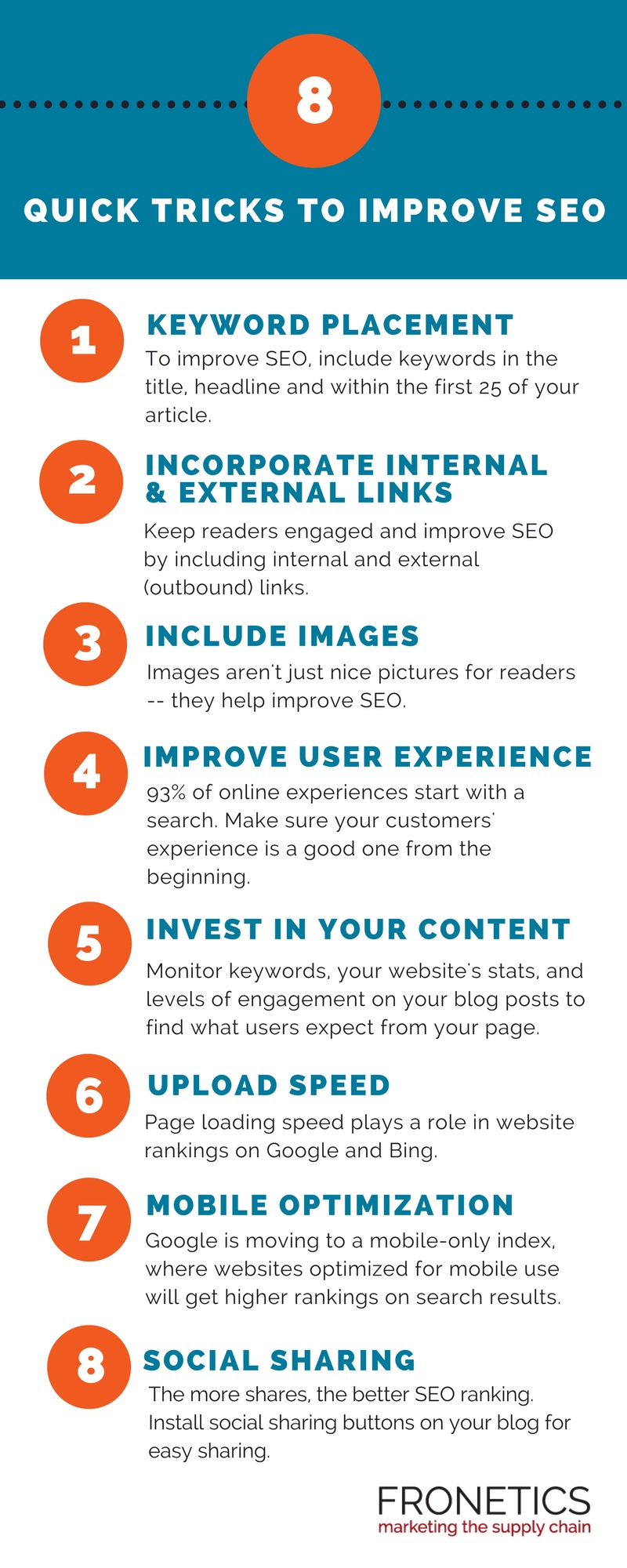
by Fronetics | Feb 5, 2018 | Blog, Content Marketing, Marketing
Internet users are changing how they search, and search engines are changing in response — which means writing for SEO is changing, too. Here’s what you need to know.
I’ve just completed a really detailed, often-complicated series about writing for SEO in today’s changing search landscape. I hope you read all four posts and now have a better understanding of the new way we marketers are thinking about content marketing.
But, as my colleagues occasionally have to remind me, not everyone enjoys the nitty gritty of SEO writing like I do. It’s also important to step back and take a look at the forest after examining the trees.
So here are some really important takeaways from the series — about how internet users, search engines, and writing for SEO are changing — that I think are important for all marketers in the supply chain and logistics industries.
4 things to know in a changing search landscape
1) Search engines are changing.
While keyword rankings used to be the gold standard for measuring SEO success, this is no longer the case. New search algorithms have moved beyond giving everyone the same results of a query, meaning that keyword ranking can change drastically depending on context (like location).
In addition, Google is increasingly showing featured snippets at the top of search results.
What you need to do:
Know that measuring SEO success is no longer as simple as keeping track of keyword rankings. It’s still information worth having, but it’s part of a larger set of metrics you need to evaluate your success and tailor your efforts.
To effectively take advantage of featured snippets, it’s important to structure your content so it’s optimized to appear in this prime location.
Read the full post.
2) People are changing how they search.
Because of the rise of mobile and voice search, people are now searching with a phrase or question rather than a single term. In response, search engine development has focused on natural language processing — meaning search engines now analyze phrases as a whole rather than a keyword. That essentially means they evaluate a site’s content regarding an entire topic rather than its use of a particular word in order to deliver the best answers to users’ queries. Basically, we’re looking at the same issue as the last post, but from the user end.
What you need to do:
Stop trying to rank for a small set of keywords. What’s important is broad visibility across a topic. You should start thinking about the major themes of your content and then build posts and website pages to support them.
Read the full post.
3) Structure your content in topic clusters and pillar content.
Pillar content is your evergreen content that offer a high-level overview of the several ideas/phrases/value propositions that most closely align with your brand. Topic clusters are the subtopics that provide more detail on those high-level ideas of your pillar content. Adding hyperlinks to pillar content pages from topic cluster pages and vice versa creates a structure that signals to search engines that your site has lots of good, well-organized information about a certain topic, which improves ranking across that topic.
What you need to do:
Structure your content into pillar content and topic clusters. Add hyperlinks between the pages. Optimize topic cluster pages to drive traffic and pillar content pages to convert leads.
Read the full post.
4) Measure the success of your content.
Measuring success is getting more complex. You can no longer effectively gauge the effectiveness of campaigns on a post-by-post basis. Instead, measure your visibility across each topic.
What you need to do:
Start looking at the bigger picture. Consider how all content under each cluster topic performs as a whole. As you do this, keep the big four questions in mind:
1) Which topics perform best at driving traffic to your website or other web presence?
2) Which topics earn you the most leads?
3) Which topics drive the most revenue to your business?
4) Which topics earn the most backlinks/coverage?
Read the full post.
Related posts:


by Fronetics | Feb 1, 2018 | Blog, Content Marketing, Logistics, Marketing, Supply Chain
Our readers voted LTX Solutions, Women In Trucking, and Apex Capital Blog as the top 3 logistics and supply chain blogs of 2018.
You voted, and the results are in! LTX Solution is your number one favorite blog of the year, with “Ellen’s Blog” of Women In Trucking and Apex Capital Blog coming in second and third.
We love hearing what blogs you enjoy reading and find valuable. There are lots of great industry options, so we know it’s not easy to narrow down your favorites. We had lots of great responses, but only Women In Trucking held its spot on our list of the top logistics and supply chain blogs from last year.
What did remain consistent from previous years is the quality of the content and the consistency of posting by the three winners. These key components have remained invaluable across all successful logistics and supply chain blogs.
Here are the top 3 logistics and supply chain blogs of 2018.
1. LTX Solutions
LTX provides professional supply chain logistics management and customer service solutions to improve transportation efficiency, reduce costs, and give companies a competitive advantage. The blog focuses on topics that impact the global supply chain, including freight management, cutting-edge data and analytics trends, and risk prevention. The blog, which consistently posts a few times a week, tackles the most pressing issues facing the supply chain industry, as well as professional tips and insight into the latest industry technology.
2. Ellen’s Blog – Women In Trucking
The Women In Trucking Association is a non-profit organization focused on encouraging the employment of women in the trucking industry, promoting their accomplishments, and minimizing obstacles. President and CEO Ellen Voie’s blog offers thought-provoking insight on topics from best practices to becoming a thought leader in a male-dominated industry. Her years of experiences and passion for advancing women’s position within the trucking industry make her blog invaluable to readers. For the second year in a row, this blog has been one of our readers’ favorites due to the relatable topics and insightful content, such as family problems stemming from job-related realities and assimilating to trucking culture.
3. Apex Capital Blog
Apex Capital specializes in factoring freight invoices for small to medium-sized trucking companies with over 20 years’ experience. Apex clients include owners and operators starting their own trucking company with one truck to large-scale companies with hundreds of trucks and employees. The blog focuses on the latest trends and happenings in the trucking industry. In the past five years the blog has published over 500 articles on topics ranging from trucking regulations, tips on running a successful trucking business, and interviews with industry leaders. The posts highlight news and information that companies can use to run and grow their trucking business.
Runner up: Muddassirism
Dr. Muddassir Ahmed’s blog focuses on all things supply chain management, including advancements in development and strategies, professional development, and improving customer experience.
Related posts:


by Fronetics | Jan 31, 2018 | Blog, Content Marketing, Current Events, Marketing, Social Media
Also in social media news January 2018: SnapChat is considering 3-second unskippable ads; Twitter will now display a video count on all video tweets; and Facebook is rolling out custom audiences for users that linger on ads.
The new year has brought lots of new changes, especially to the Facebook community. I’m sure by now you have heard about the updates to Facebook’s News Feed that are having major impacts on business page’s organic reach. But the changes don’t stop there. Twitter, Snapchat and Instagram are trying to follow Facebook’s lead and enhance their user experience. Through updates that include video counts, enhanced data collection, and recommended posts, social media is working overtime to make sure it’s active users are staying active.
Here’s your social media news for January 2018.
Facebook’s News Feed tweak penalizes pages soliciting likes and shares.
Facebook continues to make changes to News Feed — including limiting the amount of content users will see from Pages. See our full update here. Facebook also is tightening the reigns on Pages and individuals that use engagement bait to attract new followers. The site will now penalize posts that ask people to like, share, comment on, or otherwise engage with the post to boost engagement. Posts “that systematically and repeatedly use engagement bait to artificially gain reach in News Feed … will now be shown less,” the company announced in early January.
Twitter rolls out account activity API for powering customer service and chatbots
Twitter introduced a new API that will offer developers access to real-time activities, like tweets, mentions and replies, to help update their customer service tools and chatbots. The latest version of Twitter’s data collecting software is designed for those who need data for a large number of accounts, multiple URLs, or managed support.
Instagram allows users to send live video in direct messages
Instagram announced that users can now send live videos through direct messaging. By tapping on the Direct icon, users can send live video to a friend or group to encourage them to view the content. “Today’s change makes it easy to invite people to watch your live videos and send exciting live videos you’re viewing to your friends in real time,” says the announcement.
SnapChat contemplating 3-second unskippable ads
AdAge reports that Snap Inc. is giving “serious consideration” to adding 3 seconds of commercial breaks before offering a skip option on ads on SnapChat. This new ad format was created to attract more ad dollars from brands. “Advertisers are not spending as much as they have previously with SnapChat,” says the top advertiser from a brand that works closely with the messaging service. “They have to do something that draws more interest from advertisers, and they are getting more aggressive to address the market’s needs.” If implemented, the postponed skip option would be similar to YouTube’s ad experience.
Facebook testing custom audiences for users lingering on ads
Matt Navarra, director of social media for @TheNextWeb, reported a new option for targeting a list of people who have “spent more time than usual viewing your display ads on Facebook and Instagram.” The new custom audience option, called Dwell, is an expanded version of Dwell Time, which targeted people who spent any time viewing an ad. In theory, this new custom-audience option will give advertisers the ability to re-target users who viewed your ads but didn’t take any action.
Twitter displays video count on all video tweets
Twitter is adding a video count to all organic and video ads. In compliance with the Media Rating Council’s video viewability standard, Twitter will count a view once the video has been played for at least 2 seconds and with at least 50% of the video in view. This new update is a minor change to support the company’s mission to make the platform more attractive to users. “View counts are a subtle way to encourage people to share more video to the service if they feel their content is being widely seen,” writes Garrett Sloane for Adage.
Instagram rolls out recommended pages
Instagram has officially started recommending posts to users based on posts that have been liked by other accounts the user follows. The new feature is being compared to Facebook’s Explore Feed, where users can view content from a wider network, not just people and pages they follow directly. But don’t worry, the update isn’t meant to replace a user’s preferred content. The section will appear after a user has viewed all the posts in their feed, an Instagram spokesperson explains, while confirming the feature’s public launch to TechCrunch.
Related posts:


by Fronetics | Jan 29, 2018 | Blog, Content Marketing, Logistics, Marketing, Supply Chain
Use these 8 quick tips in your blog posts to improve SEO and help your target audience find your content.
Search engine optimization: It’s a phrase every blog writer looking to grow readership has wrestled with at one time or another. Part science, part art, SEO writing can evade even the most seasoned blogger. You want people searching the internet to find your blog, but you also want readers to enjoy your posts and not feel like they’re written for machines.
Search engines continue to evolve and improve their algorithms to make sure readers are finding exactly what they’re looking for. Never artificially stuff your posts with keywords, links or images. Search engines, like Google, penalize webpages that use sneaky techniques, like keyword stuffing, by demoting or even removing their pages from their indexes.
Ultimately, if you want to improve your SEO, your content needs to be value to your target audience. That should be your priority when planning and producing content like blog posts. But you can also keep these quick tricks in mind to optimize your posts, and thus increase the likelihood internet searchers will find them in the first place.
Infographic: 8 quick tips for blog posts to improve SEO

(Made with Canva)
Using these 8 quick tips will improve SEO and get your blog posts in front of your target audience. Remember, your best bet on moving up on search engine results pages is to create content that readers want to read. Sounds simple, I know, but it can be challenging. Let us know how these tips helped improve your SEO.
Related posts:

SaveSave

by Fronetics | Jan 25, 2018 | Blog, Content Marketing, Marketing
Why is no one reading your blog? Chances are, you’re not doing it right. Here are some of the blog writing mistakes you may be making.
There is so much content out there. In fact, the U.S. alone generates 2,657,700 gigabytes of internet data every minute. Every minute! That’s a whole lot of videos, tweets, posts, and photos being shared online. No wonder no one is reading your blog.
There’s so much competition out there, it’s hard to stand out against those numbers. Even with the time and energy you’re putting into your blog, you’re not seeing the views and engagement you were hoping to achieve.
Most likely, you are making one of these mistakes. Here are some reasons why no one is reading your blog.
10 reasons why no one is reading your blog: an infographic

(Made with Canva)
Related posts:

SaveSave
SaveSave
SaveSave
SaveSave

by Fronetics | Jan 24, 2018 | Blog, Content Marketing, Current Events, Logistics, Marketing, Social Media, Strategy, Supply Chain
Companies in the supply chain and logistics industries should take note of these top social media trends in 2018.
While we don’t know what 2018 has in store for companies in the supply chain and logistics industries, we do know change is coming. That is true not only in terms of the economy and your business, but also for the marketing tools you use. Of course, ever-evolving social media platforms are an important part of that.
We already know that Facebook News Feed will be making some big changes this year. What other platforms or types of media will be hot? What will your industry peers and competitors be trying in 2018? As we dive into the new year, it’s important to be aware of the social media trends that will dominate the next 12 months so you can incorporate them where you are able.
As always, good content will be as important as ever. With over one million new-data-producing social media users each day, high-quality content is the only way to stand out from the masses. But we also think you should pay attention to a few social media trends that we have highlighted in the following video. We’re certainly planning to adjust our strategy and those of our clients to consider these things.
As you start to strategize for 2018, and beyond, be sure to consider these social media trends in your content marketing plans.
Top social media trends for 2018
Make sure to follow our blog for our monthly social media news posts to stay updated on the latest platform updates. And feel free to reach out to us with questions or if you would like to see a certain social media trend covered on our blog.
Related posts:












